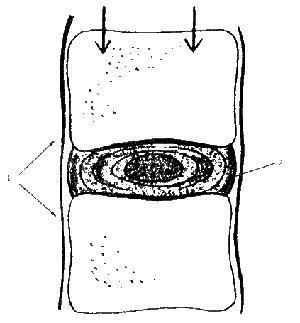Many patients speak of their problems in terms of 'bones being out of place'. They therefore expect these to be replaced or 'put back' by manipulation. Such ideas are largely inaccurate and over-simplistic. Whilst slight changes in position may take place, the essence of osteopathic manipulation is the restoration of mobility between joint surfaces. Correction of positional lesions tends to be achieved by normalizing the soft tissues that are supporting, binding and holding the bones in their particular positions. Some individuals have hypermobile joints due to congenital or acquired ligamentous weakness. Such joints can become unstable and, far from requiring manipulation, may need stabilizing by improvement of the tone of the soft tissues. This is sometimes achieved by injecting a sclerosing agent which 'tightens' the supporting tissues.
The 'Slipped Disc'
The commonest diagnosis with which patients arrive at an osteopaths door (in the UK) is that of a slipped disc. Very few doctors have studied the mechanics of the spine with the degree of detail required of the qualified osteopath. The most common diagnosis given in cases of acute low back pain is that of a 'slipped disc'. The symptoms vary, but usually involve stabbing pain on movements, and often one-sided spasm of the lumbar muscles; there is great difficulty in standing erect, and there may be pain down one or both legs. These symptoms are usually present in a true case of prolapsed intervertebral disc, but may be present in any other conditions. How is one to know?
A detailed history of the onset will often enable a correct diagnosis to be made and with details of the past medical history and a careful physical examination, it is possible to confirm or rule out the diagnosis of a slipped disc, with a great degree of certainty.
For the unfortunate individual suffering from a strained sacro-iliac joint, who is told by his doctor that he is suffering from a 'slipped disc', life becomes very irksome. He may be put to bed for anything up to six weeks, and then put into a corset. He may find himself in a plaster cast or in some cases an operation is suggested. If the patient is really suffering from a prolapsed disc ,the period in bed or wearing the corset would rest the area and enable a degree of repair to take place, but if the trouble is a strain of the sacro-iliac joint these treatments would be worse than useless.
The disc that it supposed to slip is a tough cartilaginous ring that is firmly attached to the vertebrae above and below it. This contains an inner pulpy mass, the nucleus pulposis. When through strain or an injury a tear appears in the cartilage, the inner material can protrude. This will cause spasm in the surrounding musculature and if there is pressure on nerves in the area then there will be acute pain. The disc does not, indeed cannot 'slip'. There can be a rupture, or a herniation, and thus the misnamed 'slipped disc.'
Cross Section of:
1. Vertebral Bodies Showing: |  | 2. Disc in healthy state. |
The effect of long-term unnatural wear on the disc is to reduce the elasticity of the disc as a whole and to produce a narrowing, degenerative change. Thus the ability of the disc to act as a shock-absorber becomes reduced. This results in stiffness and loss of mobility and possibly pain. It is therefore apparent that anything that can be done to prevent this all too common degeneration is highly desirable.